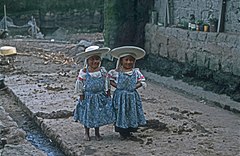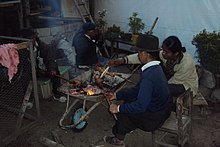30:
130:
765:
149:
291:
northern
Ecuador Andean region was estimated to have declined by 80 percent to an estimated 30,000. The Spanish put heavy demands on the Otavalo people for labor. One-fifth of the Otavalo were required to work, essentially as slave labor, for the Spanish, often in hot tropical climates to which they were not accustomed. Vineyards owned by the
326:
Most
Otavalo are subsistence farmers who cultivate crops like potatoes but also raise livestock. Some work in the textile industry where many traditional Otavalo-styled textiles (woven with alpaca or llama wool) are exported to North America. A few Otavalo are businessmen or women who run some of
290:
The
Spanish conquered the Inca Empire in the 1530s and Spanish settlement began. The Inca and Spanish conquests and the Spanish rule of the Otavalo and other nearby chiefdoms, plus recurrent epidemics of European diseases, had a profound impact on the population. By 1582, the population of the
265:
continued to operate among the
Otavalo. The mindaláes appear to have operated outside the authority of the chiefdoms. They carried on trade with the people living in lower elevations on the western slopes of the Andes, especially in the
327:
these textile operations. Tourism is another significant source of revenue as these outsiders are attracted to the area because of the culture and local dress of the people.
544:
318:
In 1990, the number of
Otavalo people was estimated at 45,000 to 50,000 in the Otavalo area with another 5,000 to 8,000 living elsewhere in Ecuador or other countries.
307:
Unlike many others the
Otavalo survived as a distinct ethnic group, but sometime after the 16th century they lost their original language and henceforth spoke
76:
537:
368:
Bray, Tamara L. and
Echeverría Almeida, José (2014), "The Late Imperial Site of Inca-Caranqui, Northern highland Ecuador at the End of Empire",
257:(people forcibly resettled outside their homelands by the Incas) were moved into the Otavalo region. Also contrary to the Incas who used the
188:. These chiefdoms appear to have been similar in artistic techniques, subsistence, settlement patterns, and language, probably all speaking
140:
The
Otavalo live in the high, cool altitudes of the Andes. The city of Otavalo is located at an elevation of 2,532 metres (8,307 ft).
530:
788:
721:
210:
The
Otavalo area was densely populated. The Otavalo people practiced irrigation agriculture and constructed camelones or
118:
in that province. Commerce and handcrafts are among the principal economic activities of the
Otavalos, who enjoy a higher
270:
valley, about 75 kilometres (47 mi) north of the city of Otavalo. Products they brought to the highlands included
253:
The brief period of Inca rule apparently did not change Otavalo culture much. Contrary to Incan practice, few if any
489:
793:
751:
561:
553:
299:
church were characterized as "fields of blood" because of the Otavalo laborers who died working there.
267:
451:
195:
The Otavalo and other Andean people of northern Ecuador are often identified with the pre-Columbian
192:. The four chiefdoms collectively had an estimated pre-Inca population of 100,000 to 180,000.
172:, an area 150 kilometres (93 mi) long by the same width, consisted of several small-scale
736:
746:
741:
716:
258:
8:
731:
726:
189:
569:
481:
119:
695:
589:
485:
107:
99:
522:
611:
312:
181:
134:
61:
690:
670:
711:
648:
626:
621:
599:
574:
347:
292:
594:
226:
and other tropical and sub-tropical crops were important products. Domesticated
769:
653:
643:
115:
782:
675:
638:
616:
584:
204:
177:
680:
631:
200:
234:. Prior to the Incas, the Otavalo apparently did not possess domesticated
185:
196:
161:
73:
685:
227:
153:
29:
261:
to exchange goods among regions, a class of long-range traders called
230:
were an important source of animal protein, as was wild game such as
211:
665:
579:
296:
173:
169:
129:
604:
279:
247:
123:
111:
45:
308:
271:
239:
219:
148:
57:
254:
235:
215:
165:
103:
398:
Vol. 1, 2nd edition, American Indian Publishers, pp. 220-221
207:, whence comes the name of the Ecuadorian capital of Quito.
164:
in the late 15th or early 16th century, the region north of
275:
243:
231:
223:
214:
raised fields to regulate the supply of water for crops.
160:
Prior to the incorporation of the Otavalo people into the
552:
446:
444:
420:, Cambridge: Cambridge University Press, pp. 81–82
152:Indigenous people of the Otavalo people, roasting
385:, Norman: University of Oklahoma Press, pp. 39–40
780:
441:
396:Dictionary of the Indian Tribes of the Americas,
122:than most indigenous groups in Ecuador and many
538:
418:Native lords of Quito in the age of the Incas
545:
531:
512:University of Chicago Press, Chicago, 1949
370:Nampo Pacha, journal of Andean Archaeology
517:Otavalo: Weaving, Costume and the Market.
508:Collier, John, Jr., and Buitrón, Aníbal.
383:Life and Death in Early Colonial Ecuador
315:dialect spoken in Ecuador, and Spanish.
203:and as descendants of the semi-mythical
147:
128:
475:
242:as did Andean peoples further south in
781:
526:
16:Indigenous people of northern Ecuador
222:and, at lower and warmer altitudes,
40:Regions with significant populations
34:Otavalo girl in traditional clothing
519:Ediciones Libri Mundi, Quito, 1987.
13:
502:
478:Human: The Definitive Visual Guide
344:Las Costumbres de los Ecuatorianos
14:
805:
554:Ancestry and ethnicity in Ecuador
763:
114:. The Otavalos also inhabit the
88:Other Andean peoples of Ecuador
28:
469:
285:
168:near the border of present-day
432:
423:
410:
401:
388:
375:
362:
353:
337:
302:
1:
789:Indigenous peoples in Ecuador
476:Winston, Robert, ed. (2004).
330:
7:
10:
810:
429:Newsom, 34–37; Salomon 102
321:
278:, and dried fish from the
143:
760:
704:
560:
438:Newsom, pp 38–40, 163–164
381:Newson, Linda A. (1995),
87:
82:
72:
67:
56:
51:
44:
39:
27:
372:, Vol. 34, No. 2, p. 182
452:"Orientation - Otavalo"
416:Salomon, Frank (1986),
176:including the Otavalo,
794:Pre-Columbian cultures
157:
137:
510:The Awakening Valley.
394:Onofrio, Jan (1995),
151:
133:Two Otavalo girls in
132:
83:Related ethnic groups
456:www.EveryCulture.com
259:vertical archipelago
190:Barbacoan languages
24:
770:Ecuador portal
482:Dorling Kindersley
158:
138:
120:standard of living
77:Andean Cosmovision
22:
776:
775:
407:Newsom, pp. 33–36
108:Imbabura Province
100:indigenous people
92:
91:
801:
768:
767:
766:
547:
540:
533:
524:
523:
496:
495:
473:
467:
466:
464:
462:
448:
439:
436:
430:
427:
421:
414:
408:
405:
399:
392:
386:
379:
373:
366:
360:
357:
351:
341:
135:Cayambe, Ecuador
104:Andean mountains
32:
25:
21:
809:
808:
804:
803:
802:
800:
799:
798:
779:
778:
777:
772:
764:
762:
756:
700:
575:Canelos-Quichua
556:
551:
505:
503:Further reading
500:
499:
492:
484:. p. 378.
474:
470:
460:
458:
450:
449:
442:
437:
433:
428:
424:
415:
411:
406:
402:
393:
389:
380:
376:
367:
363:
358:
354:
348:Osvaldo Hurtado
342:
338:
333:
324:
305:
293:Dominican Order
288:
146:
126:of their area.
116:city of Otavalo
35:
20:
17:
12:
11:
5:
807:
797:
796:
791:
774:
773:
761:
758:
757:
755:
754:
749:
744:
739:
734:
729:
724:
719:
714:
708:
706:
705:Non-Indigenous
702:
701:
699:
698:
693:
688:
683:
678:
673:
668:
663:
658:
657:
656:
654:Quijos-Quichua
651:
641:
636:
635:
634:
629:
624:
619:
609:
608:
607:
597:
592:
590:Cholo pescador
587:
582:
577:
572:
566:
564:
558:
557:
550:
549:
542:
535:
527:
521:
520:
515:Meisch, Lynn.
513:
504:
501:
498:
497:
490:
468:
440:
431:
422:
409:
400:
387:
374:
361:
352:
335:
334:
332:
329:
323:
320:
304:
301:
287:
284:
145:
142:
102:native to the
90:
89:
85:
84:
80:
79:
70:
69:
65:
64:
54:
53:
49:
48:
42:
41:
37:
36:
33:
18:
15:
9:
6:
4:
3:
2:
806:
795:
792:
790:
787:
786:
784:
771:
759:
753:
750:
748:
745:
743:
740:
738:
735:
733:
730:
728:
725:
723:
720:
718:
715:
713:
710:
709:
707:
703:
697:
694:
692:
689:
687:
684:
682:
679:
677:
674:
672:
669:
667:
664:
662:
659:
655:
652:
650:
647:
646:
645:
642:
640:
637:
633:
630:
628:
625:
623:
620:
618:
615:
614:
613:
610:
606:
603:
602:
601:
598:
596:
593:
591:
588:
586:
583:
581:
578:
576:
573:
571:
568:
567:
565:
563:
559:
555:
548:
543:
541:
536:
534:
529:
528:
525:
518:
514:
511:
507:
506:
493:
491:0-7566-0520-2
487:
483:
479:
472:
457:
453:
447:
445:
435:
426:
419:
413:
404:
397:
391:
384:
378:
371:
365:
356:
349:
345:
340:
336:
328:
319:
316:
314:
310:
300:
298:
294:
283:
281:
277:
273:
269:
264:
260:
256:
251:
249:
245:
241:
237:
233:
229:
225:
221:
217:
213:
208:
206:
205:Quitu culture
202:
198:
193:
191:
187:
183:
179:
175:
171:
167:
163:
155:
150:
141:
136:
131:
127:
125:
121:
117:
113:
109:
105:
101:
97:
86:
81:
78:
75:
71:
66:
63:
59:
55:
50:
47:
43:
38:
31:
26:
660:
516:
509:
480:. New York:
477:
471:
459:. Retrieved
455:
434:
425:
417:
412:
403:
395:
390:
382:
377:
369:
364:
359:Google Earth
355:
350:. p. 260-270
343:
339:
325:
317:
306:
289:
286:Spanish rule
262:
252:
209:
201:Cara culture
194:
159:
156:on charcoal.
139:
110:in northern
95:
93:
19:Ethnic group
570:Awa-Kwaiker
303:Present day
228:guinea pigs
197:Cara people
162:Inca Empire
154:guinea pigs
74:Catholicism
783:Categories
737:Uruguayans
686:Taromenane
562:Indigenous
331:References
268:Mira River
742:Croatians
717:Americans
263:mindaláes
212:Waru Waru
186:Cochasquí
174:chiefdoms
52:Languages
747:Lebanese
732:Mestizos
727:Italians
722:European
696:Tsáchila
649:Panzaleo
627:Huambisa
622:Aguaruna
612:Jivaroan
600:Huaorani
346:. 2007.
297:Catholic
274:, coca,
220:potatoes
178:Caranqui
170:Colombia
124:mestizos
96:Otavalos
68:Religion
712:African
661:Otavalo
644:Quichua
605:Tagaeri
322:Economy
313:Quechua
295:of the
282:coast.
280:Pacific
248:Bolivia
240:alpacas
182:Cayambe
144:History
112:Ecuador
98:are an
62:Spanish
46:Ecuador
23:Otavalo
691:Teteté
676:Secoya
671:Sápara
666:Puruhá
617:Achuar
585:Chachi
580:Cañari
488:
461:12 May
311:, the
309:Kichwa
272:cotton
236:llamas
184:, and
58:Kichwa
681:Siona
639:Maina
632:Shuar
595:Cofán
255:mitma
216:Maize
166:Quito
752:Jews
486:ISBN
463:2017
276:salt
246:and
244:Peru
238:and
232:deer
224:coca
199:and
94:The
106:of
785::
454:.
443:^
250:.
218:,
180:,
60:,
546:e
539:t
532:v
494:.
465:.
Text is available under the Creative Commons Attribution-ShareAlike License. Additional terms may apply.


